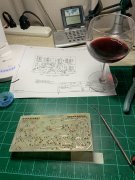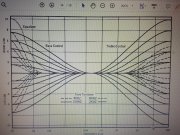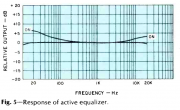So... It's all back together - and working. There are, however, some interesting discoveries. After putting it back together and performing some initial checks, I began running the Test Procedures outlined in the service manual. Everything checked okay except the Active Equalizer at the 20kHz frequency. Instead of getting a 2 to 4dB increase, mine was ruler flat. This is a relatively minor issue, but being an engineer, I wanted to know why and began to dig deeper. The Active Equalizer is supposed to provide, when active, a 7-9dB boost at the low frequencies (20Hz) and a 2-4dB boost at 20kHz. The circuitry that does this resides mostly on the Tone Amplifier along with an RC network of the front panel made up of R58/C28 and R59/C29. When I looked on the front panel for these components, I found nothing. They are missing. I suspect they have been removed, since their mounting holes are soldered over, but it's possible they were never installed.
I had to grin a little when I saw your post.
It amazes me how many times I see someone selling a 4000 on ebay stating that it works perfectly. When if in fact they tried to use the "test procedures" in the service manual they would run into what you did. Either they would choose to ignore it or attempt to do something about it.
Please allow me to step back in time a little bit. Many years ago I had a stack of 4000's (S/N greater than 2500) I had accumulated. I had gone through them all doing the normal repairs that I do, re-doing all the solder joints on the motherboards and "daughter" boards, replacing electrolytic capacitors, cleaning/lubricating potentiometers, switches, etc. Then came time for testing and I ran into exactly what you did with every single one of my 4000's.
Reading the service manual it states:
7. Switch the ACTIVE EQUALIZER in(up) and verify less than 2dB change in output signal level at 2KHz
8. Repeat step 7 above at 20Hz and verify an increase of 7 to 10dB in output signal level.
9. On models with serial number greater than 2500 repeat step 7 above at 20KHz and verify an increase of 2 to 4dB in output signal.
I walked 2 houses down to my neighbor Dean Nissen's house. (NOTE: Dean was the last factory service manager at Phase Linear.) I asked Dean about this since he would know the answer and he was the one who last revised the service manual in 6/1981.
Dean informed me that indeed Phase Linear made a change at serial number 2500 but they (Phase Linear) decided later on to change the circuit back to what it was before then. Unfortunately, there is no notation in the service manual at what serial number this change back to what is was before S/N 2500 occurred out.
I also have a marked up copy of Dean's service manual and he makes no notation about this in it.
So whenever I would sell any of the 4000's I had on ebay, I would state that I followed the test procedures as outlined in the service manual along with the knowledge I had gained with working with Dean for over 25 years!
Ed




